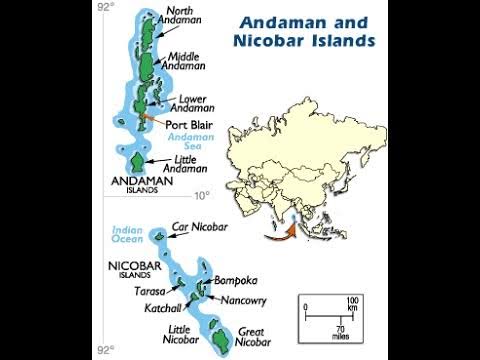



Explained: What is INS Baaz, and why is it important?
Security or Defence
Explained: What is INS Baaz, and why is it important?
Navy Chief Admiral Karambir Singh visited INS Baaz, the southernmost air station of the Indian Armed Forces and spent a day with personnel stationed there.
Location of INS Baaz:
- INS Baaz is located at Campbell Bay on the Great Nicobar Island, the southernmost and largest island of the Nicobar Islands, in the Union Territory of Andaman and Nicobar Islands.
- This island is also the location of the Indira Point and is less than 250 km by sea from Banda Aceh in Indonesia.
- Campbell Bay, where the base is located, is more than 1,500 km away from the Indian mainland, and 500 km from Port Blair.
Strategic importance of INS Baaz:
- The Andaman & Nicobar Islands are strategically important for India’s national security as they provide a critical capability to monitor sea areas in the region.
- The location has been described as India’s “window into East and Southeast Asia”, and is in close vicinity of the Six Degree Channel, also called the Great Channel, one of the Indian Ocean’s busiest shipping lines, carrying strategic cargo to East Asian countries.
- It is also close to the Strait of Malacca.
- The INS Baaz helps to ensure maritime security in the Bay of Bengal and the Andaman Sea, and substantially enhances the Indian Navy’s maritime surveillance capability.
- The base also assists the local populace in times of need such as facilitating evacuation during medical emergencies.

Polity
Explained: The difference between parole and furlough
Ajay Chautala, founder of the Jannayak Janata Party (JJP), and father of Haryana’s new deputy chief minister Dushyant Chautala, was granted furlough for two weeks on Saturday, and released from Delhi’s Tihar jail on Sunday morning.
Parole:
- Parole is a system of releasing a prisoner with suspension of the sentence.
- The release is conditional, usually subject to behaviour, and requires periodic reporting to the authorities for a set period.
- Parole is considered a reformative process.
- The provision (along with furlough) was introduced with a view to humanising the prison system.
- In India, parole (as well as furlough) is covered under The Prisons Act of 1894.
- Prisoners convicted of multiple murders or under the anti-terror Unlawful Activities Prevention Act (UAPA) are not eligible for parole.
- Since prisons are a State subject in the Constitution, the Prisons Act of each state government defines the rules under which parole is granted in that state.
- Apart from regular parole, the superintendent of a jail can also grant parole up to a period of seven days in emergencies. Actor Sanjay Dutt was granted parole on medical grounds.
Furlough:
- Furlough is given in cases of long-term imprisonment.
- The period of furlough granted to a prisoner is treated as remission of his sentence.
- Furlough is seen as a matter of right for a prisoner, to be granted periodically irrespective of any reason, and merely to enable the prisoner to retain family and social ties, and to counter the ill effects of prolonged time spent in prison.
- Parole, by contrast, is not seen as a matter of right, and is given to a prisoner for a specific reason, such as a death in the family or a wedding of a blood relative.

Environment
Explained: Day light Saving Time
About Daylight Saving Time (DST):
Clocks in Europe went back an hour on Sunday, signalling the end of Daylight Saving Time (DST) this year. In the Southern Hemisphere, the opposite has happened. Thus, clocks have gone ahead by an hour — in New Zealand.
Changes with respect to Indian time:
- Now that DST has ended in Europe and clocks have gone back an hour, the time difference between London and India is five and a half hours (and that between Paris or Berlin and India is four and a half hours).
- When it was on DST or British Summer Time (BST), the time difference between London and India was four and a half hours (three and a half hours for Paris or Berlin).
Reason for DST:
- DST is in use during the period from spring to autumn (or fall), when Europe and the United States get an extra hour of daylight in the evening.
- The idea is to make better use of daylight.
- Clocks are moved back to same time on prefixed dates when day begins to get shorter (as in winter).
- In April 1916, during World War I, with Europe facing severe coal shortages, Germany and Austria-Hungary introduced DST to minimise the use of artificial lighting.
Countries following DST:
- Europe, US, New Zealand and Australia follows the DST
- Countries along the equator do not follow DST, as there is not much difference in day length.
- India does not have DST.
- Most Muslim countries do not use DST — during the holy month of Ramzan, this could mean delaying the breaking of the fast for longer.
- Morocco has DST, but suspends it during Ramzan. However, Iran has DST, and stays with it even during Ramzan.
Challenges to DST:
- The basic idea of DST is under challenge from the very modern societies work. There are grave doubts that DST actually saves much energy.
- Modern societies use so much energy-consuming appliances all day long that the amount of energy saved is actually negligible.
- One hour of lost sleep in the US, one study calculated, increases the fatal crash rate by 5.4% to 7.6% for six days following the transition.
- Higher rate of workplace injuries after the switch, leading to loss days of work.
Economy
Market incentives, direct income support for farmers are far more effective in increasing agricultural productivity
Comparison between India and China:
- China cultivates around 120 million hectare while India cultivate 136 million hectares.
- Both have adopted modern technologies in agriculture, starting with high yield variety (HYV) seeds, in the mid-1960s, increasing irrigation cover and using more chemical fertilisers to produce more food from limited land.
- Chinese irrigation cover is 41% of total arable land while Indian irrigation cover is 48%.
- Despite having lower arable land, Chinese output is $1367 billion while Indian output is $407 billion.
Learning from China:
A) Investment in innovation:
- China spends a lot more on agriculture knowledge and innovation system (AKIS), which includes agri R&D and extension.
- China invested $7.8 billion on AKIS in 2018-19, 5.6 times the amount spent by India — $1.4 billion.
- According to a study estimated that for every rupee invested in R&E, agriculture GDP increases by Rs 11.2; and for every million rupees spent on agri-R&E, 328 people are brought out of poverty.
- India invests just about 0.35 per cent of its agri-Gross Value Added (GVA) while China spends 0.8 per cent (expenditure by Centre only)
- China’s fertiliser consumption in 2016 was 503 kg/ha of arable area compared to just 166 kg/ha for India, as per World Bank estimates.
- China’s productivity in most crops is 50 to 100 per cent higher than India’s.
B) Producer support estimates:
The PSE concept adopted by 52 countries, that produce more than three-fourths of the global agri-output, measures the output prices that farmers get in a free trade scenario.
- For Chinese farmers, the PSE was 15.3 per cent of the gross farm receipts during the triennium average ending (TE) 2018-19.
- For the same period, Indian farmers had a PSE of negative 5.7 per cent.
- This reflects that Indian farmers had been taxed much more than they have been subsidised — despite high amounts of input subsidies.
- This negative PSE (support) is fallout of restrictive marketing and trade policies that do not allow Indian farmers to get free trade prices for their output.
- The solution for correcting this situation is to carry out large-scale agri-marketing reforms (APMC and Essential Commodities Act).
C) Direct Income Support Scheme:
- China has combined its major input subsidies in a single scheme, which allows direct payment to farmers on per hectare basis and has spent $20.7 billion for this purpose in 2018-19.
- This gives the farmers freedom to produce any crop rather than incentivising them to produce specific crops.
- Inputs are priced at market prices giving right signals to farmers to use resources optimally.
- India, on the other hand, spent only 3 billion dollars under its direct income scheme, PM-KISAN in 2018-19, but the country has spent $27 billion on heavily subsidising fertilisers, power, irrigation, insurance and credit.
- This leads to large inefficiency in their use and creates environmental problems.
- It may be better for India to also consolidate all its input subsidies, give them directly to farmers on per hectare basis, and free up prices from all controls.

© 2025 iasgyan. All right reserved